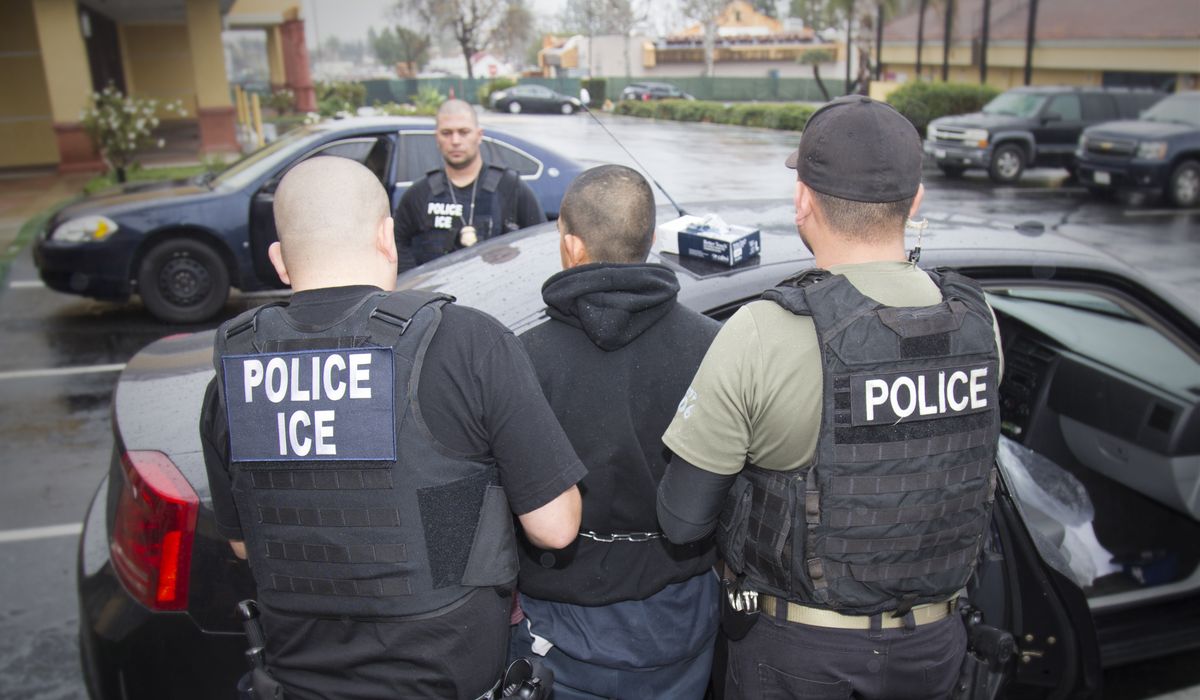

Immigrants report crimes at the same rate as native-born Americans, according to a new report that undercuts sanctuary cities’ claims that cooperating with immigration authorities creates a “chilling effect,” making migrants less likely to work with local police on their investigations.
The Center for Immigration Studies used crime victimization data to look at how often crimes were reported by Hispanics versus non-Hispanics, and more precisely for the immigration context, how often crimes were reported by citizens and non-citizens.
The analysts said if anything, they found higher reporting among immigrants, compared to native-born Americans. For example, Hispanic immigrants, both citizens and non-citizens, reported 65% of serious violent crimes from 2017 to 2019, compared to just 49% of native-born.
And the data showed fear of police or deportation wasn’t a major hindrance, with about 1% of immigrant victims saying they feared harassment by authorities or were advised not to tell the police.
It also didn’t matter whether the immigrants lived in the types of communities most likely to be sanctuaries or not, the CIS study said. Crime reporting was similar no matter what.
“Immigrants do not generally shy away from reporting crimes – all types of crimes, all over the country – more than anyone else,” said Jessica Vaughan, the study’s lead author. “Not only that, of those that don’t report crimes, they almost never say it was because they feared trouble from the police, or implied that they feared deportation.”
The study strikes at the heart of the most compelling defense of sanctuary policies, which shield illegal immigrants from being reported or turned over to federal deportation authorities.
While some immigrant activists defend sanctuary policies in terms of protecting illegal immigrants, most sanctuary cities justify their rules as a public safety measure, saying they fear if they work with federal authorities, then immigrants will curtail reporting crimes.
In early 2017, for example, Los Angeles reported seeing a major drop in Hispanic crime reporting of sexual assaults and domestic violence over the first two months of the Trump administration, which city officials attributed to people being scared of deportation.
The city’s police chief and mayor highlighted the numbers at a press conference.
“While there is no direct evidence that the decline is related to concerns within the Hispanic community regarding immigration, the department believes deportation fears may be preventing Hispanic members of the community from reporting when they are victimized,” the Los Angeles Police Department said.
But The Washington Times looked at a broader set of data from Los Angeles stretching beyond the first two months and found the city’s claims weren’t borne out.
Indeed, Hispanic crime reporting for intimate partner aggravated assaults was almost the exact same share of total reports from 2016, under President Obama, to 2017, under President Trump, while rape reporting actually rose slightly.
California then enacted a series of statewide sanctuary policies that took effect in 2018, which under Los Angeles’ theory of crime reporting should have led to a spike in Hispanic reports of crimes. Reports of rape and domestic partner simple assaults did rise slightly, but aggravated assault reports fell.
The crime victimization data used by CIS for the new analysis is a survey taken by the Census Bureau on behalf of the Justice Department. Beginning in 2017, the survey included questions about citizenship and foreign birth, giving a new window into trends among immigrants.
Among the findings were that 62% of serious crimes against immigrants — both legally and illegally present — were reported to police, compared to 53% for the native-born population. For violent crimes, immigrants reported 61%, compared to 49% for the native-born.
The CIS analysis used Hispanic non-citizens as a rough proxy for illegal immigrants and found even among that population, there wasn’t a major difference in reporting compared to native-born Americans.
“We find no evidence in the NCVS data to support the ‘chilling effect’ theory that immigrants are more reluctant to report crimes, generally, or in the parts of the country where local authorities routinely cooperate with ICE, such as the South,” the authors concluded.
The CIS analysis contradicts other studies, such as a paper published in January in the American Sociological Review that looked at data from 1980 to 2004 and concluded that cooperating with federal authorities did suppress crime reporting.
“We find that Latinos are more likely to report violent crime victimization to law enforcement after
sanctuary policies have been adopted within their metropolitan areas of residence,” that study concluded.
Another study released in January used the same victimization data as CIS and found that Hispanic crime reporting seemed to drop in 2017, when the Trump administration took over.
But CIS said the data set isn’t good enough to make judgments based on a single year-to-year change, and besides, Hispanics were still just as likely to report crimes as non-Hispanics in 2017.
